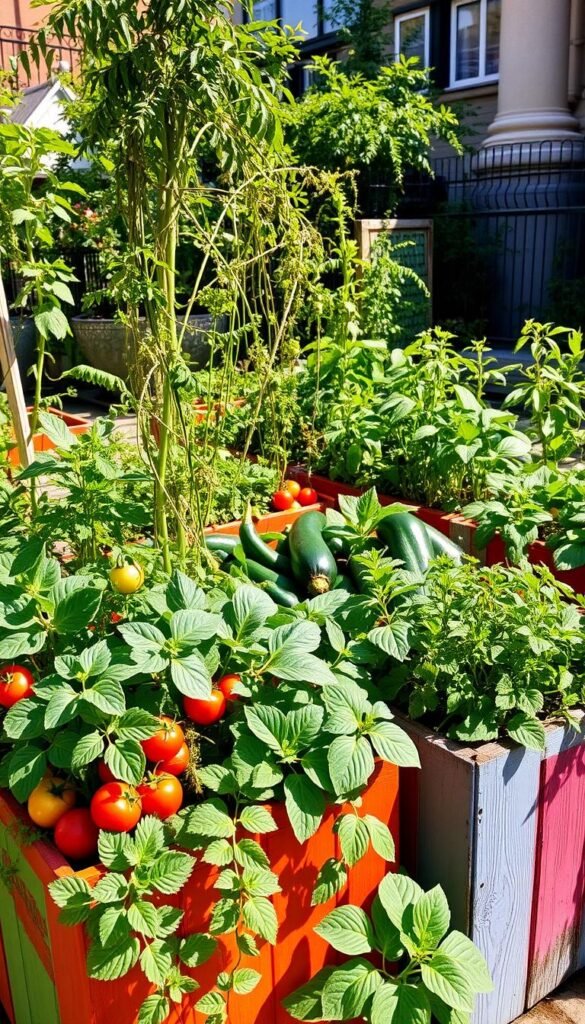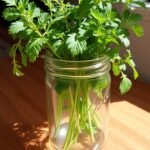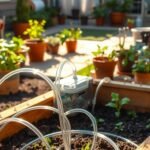Transforming small outdoor areas into lush edible paradises has never been easier. Whether you’re working with a sunny balcony or a narrow patio, modern growing methods let you cultivate fresh ingredients without traditional garden beds. This approach gives you complete command over soil quality, drainage, and sun exposure for every plant.
Urban dwellers and renters particularly benefit from this flexible system. Pots and planters let you adapt to changing sunlight patterns by simply moving your green companions. Imagine growing juicy tomatoes next to fragrant basil, then shifting them to catch afternoon rays as seasons change.
Your success starts with smart planning. Compact varieties of peppers, leafy greens, and root crops thrive in confined areas when paired with proper care techniques. Selecting the right vegetable varieties ensures bountiful harvests from spring through fall. With strategic watering and companion planting, you’ll create mini ecosystems where each species supports its neighbors.
This method isn’t just practical – it’s deeply rewarding. Picture plucking sun-warmed strawberries from your fire escape or garnishing meals with herbs grown steps from your kitchen. Every container becomes a personalized food factory, proving that limited square footage can’t limit your green thumb ambitions.
Planning Your Container Garden: Strategies for Small Spaces
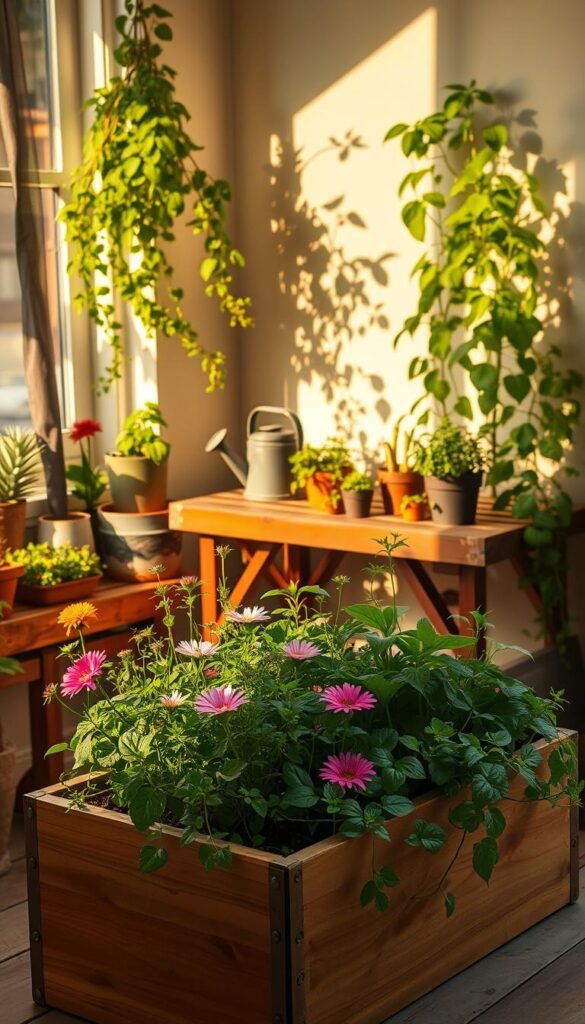
Creating a thriving edible oasis starts with smart spatial planning. Begin by measuring your balcony, patio, or windowsill to understand what fits. Light patterns change throughout the day, so track sun exposure across your area for three consecutive days.
Sunlight & Spatial Analysis
Most edible plants need 6-8 hours of direct sun. Use a free app like Sun Seeker to map shadows and bright spots. South-facing spaces often get the most light, but don’t worry if yours faces east or west – many greens grow well with 4 hours of morning rays.
Layout & Growing Medium Setup
Arrange containers like chess pieces – leave room for growth and airflow. A 5-gallon bucket fits one tomato plant, while shallow pots work for radishes. Mix your soil using this recipe:
| Component | Purpose | Ratio |
|---|---|---|
| Potting Mix | Base structure | 50% |
| Compost | Nutrients | 30% |
| Perlite | Drainage | 20% |
Group thirsty crops like cucumbers near water sources. Place mint and basil where you’ll pass them daily – their fragrance doubles as natural pest control. Remember: lightweight planters let you chase the sun as seasons change!
Container Vegetable Garden Ideas: Maximize Yields in Limited Spaces
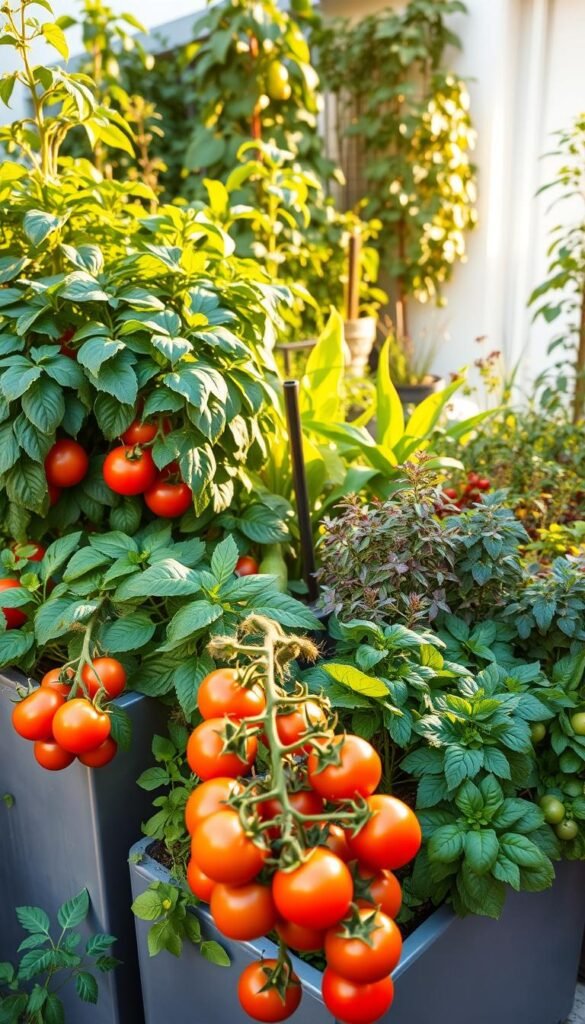
Discover how strategic planting patterns can triple your edible output without expanding your footprint. Urban growers are adopting cutting-edge techniques that challenge traditional growing norms, proving that size constraints fuel creativity rather than limit productivity.
Innovative Approaches for High-Yield Designs
The square-foot strategy revolutionizes planter use by dividing soil areas into precise grids. One-foot sections let you alternate between 16 carrot seedlings and single broccoli plants, adapting to each crop’s needs. This organized approach prevents overcrowding while doubling your harvest potential compared to random planting.
Keep your pots productive year-round through staggered sowing. Start lettuce seeds every 14 days for non-stop leafy greens, then follow with cool-weather varieties as temperatures drop. Pair this with space-saving dwarf tomatoes that deliver full-sized fruits on compact vines.
Elevate your setup literally and figuratively with tiered plant stands. Position trailing strawberries above bush beans to create multiple growing zones. Below them, quick-growing radishes share space with slower carrots – when you pull the radishes, the carrots gain room to mature.
These methods work best when you refresh soil between plantings and monitor nutrient levels closely. Rotate heavy feeders like spinach with nitrogen-fixing peas to maintain soil vitality. With smart planning, your concentrated growing area becomes an ever-changing buffet of fresh flavors.
Choosing the Perfect Containers for Your Garden
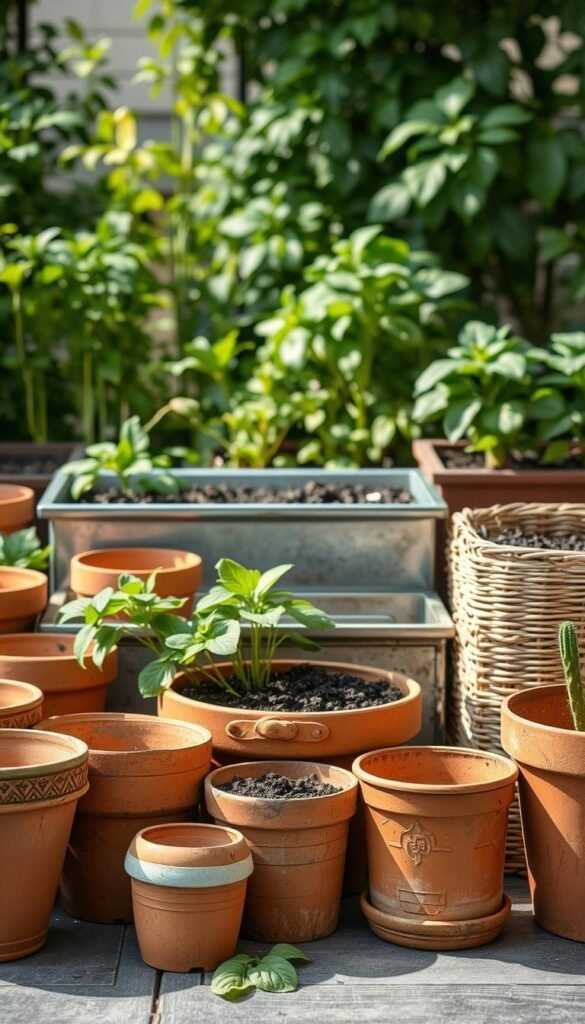
Your planters are more than just pots—they’re the foundation of your garden’s success. The right materials and dimensions directly impact your plants’ health while complementing your living space. Let’s explore how to balance practicality with personal style.
Material, Size, and Durability
Lightweight plastic works well for movable setups, especially if you rearrange often. Look for BPA-free options to keep edibles safe. Terra cotta’s porous nature helps roots breathe but requires frequent watering—perfect for herbs like rosemary that hate soggy soil.
Fabric grow bags shine for deep-rooted crops. They prevent tangled roots and fold flat when empty. For permanent installations, consider ceramic or metal—just drill extra drainage holes. Always match planter depth to your crops’ needs. A 12-inch-wide pot suits peppers, while carrots need deeper homes.
Style Options to Suit Your Home Aesthetic
Modern fiberstone planters add sleek lines to urban balconies, while wooden boxes create rustic charm. Colorful ceramic pots pop against neutral walls, doubling as art pieces. Group varying heights for visual interest—tall planters behind trailing strawberries create depth.
For long-term setups, invest in frost-resistant materials that last years. Rotate seasonal accents like painted trays or decorative mulch to refresh your space. Need guidance? Our guide to right container size helps match pots to specific crops.
Optimizing Soil, Watering, and Fertilization
The secret to thriving plants lies beneath the surface. Quality growing mediums and smart hydration practices turn confined spaces into food-producing powerhouses. Let’s explore how to create ideal conditions for roots while beating summer heat challenges.
DIY Soil Mix for Better Drainage and Nutrition
Whip up a custom blend using equal parts compost, peat moss (or eco-friendly coco coir), and perlite. This trio works like a dream team:
- Compost feeds plants with nutrients and beneficial microbes
- Peat moss acts as a moisture manager
- Perlite keeps roots oxygenated
Need adjustments? Add extra perlite for herbs that hate wet feet, or more vermiculite for thirsty greens. Pro tip: Mix large batches in a wheelbarrow – you’ll save 40% compared to store-bought bags!
Efficient Watering Techniques for Hot Summers
When thermometers hit 85°F, pots can dry out twice daily. Water deeply at sunrise – this gives plants a hydration boost before the day’s heat. Use a watering can with a long spout to target soil directly, avoiding leaf splash.
Consider these summer survival tools:
| Tool | Benefit | Best For |
|---|---|---|
| Drip irrigation | Consistent moisture | Vacation days |
| Self-watering pots | Reduces frequency | Leafy greens |
| Mulch layer | Cuts evaporation | All plants |
Feed plants every 14 days with organic fish emulsion. As one urban gardener notes: “My balcony tomatoes doubled in size once I started fertilizing with seaweed tea.” Remember – frequent watering washes away nutrients faster than in ground beds!
Vertical Gardening to Expand Your Growing Space
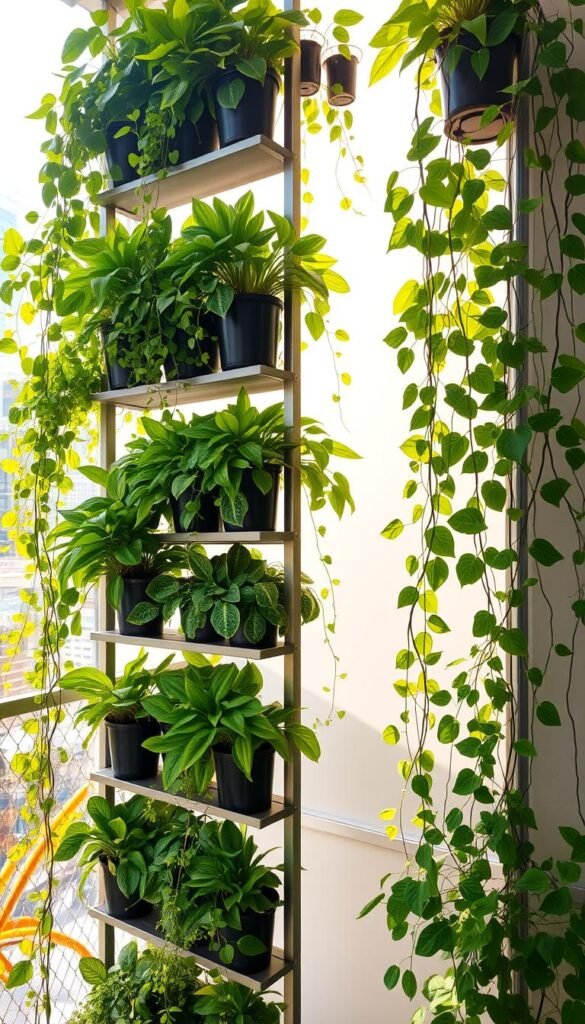
Reach new heights with vertical gardening techniques that turn walls and railings into edible displays. This smart approach lets you grow more plants in tight areas while adding visual drama to your setup. Vining crops like Malabar spinach and Bolivian cucumber thrive when given room to climb, creating living curtains of fresh produce.
Building Trellises and A-Frame Supports
Create custom climbing systems using materials you already own. Bamboo poles lashed together form lightweight A-frames perfect for beans and peas. For heavy producers like squash, try metal posts with welded wire grids – they handle weight better than twine.
| Material | Best For | Setup Time |
|---|---|---|
| Bamboo | Lightweight vines | 15 minutes |
| Metal posts | Heavy crops | 30 minutes |
| Wooden stakes | Tomatoes | 10 minutes |
Position these structures where they won’t block sunlight from other plants. One gardener reported: “My cucumber yield tripled when I switched from ground spread to vertical growth.”
Benefits of Growing Upwards
This way to grow keeps leaves dry and fruits clean by lifting them off damp soil. Pole beans and cherry tomatoes benefit most from improved air flow – you’ll spot fewer mold issues.
Use the shaded areas beneath your structures for heat-sensitive greens. Lettuce and spinach appreciate summer protection while your climbing plants soak up full sun above. It’s like having two gardens in one space!
Try training different vines on the same support for variety. Pair purple hyacinth beans with yellow summer squash – you’ll get stunning colors and multiple harvests from a single vertical space.
Maximizing Crop Yield with Succession Planting
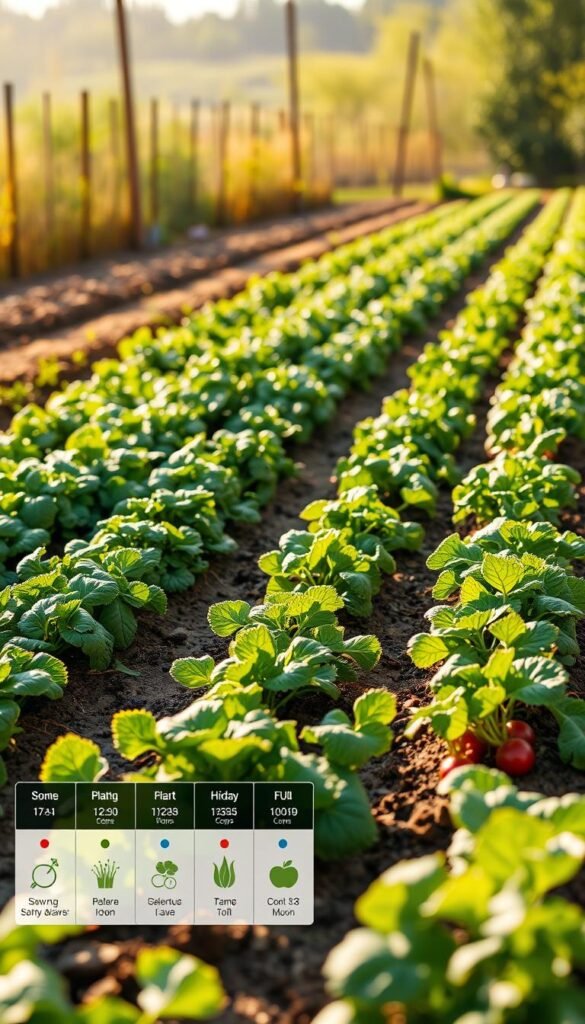
Keep your pots productive year-round with clever timing strategies. This method lets you harvest fresh greens and juicy tomatoes long after neighbors have cleared their plots. By cycling crops in sync with nature’s rhythms, you turn limited areas into non-stop food factories.
Smart Scheduling for Continuous Bounty
Start lettuce seeds every 10 days for salads that never run out. When your first radish batch gets pulled, immediately sow bush beans in the warm soil. This tag-team approach works best when you track growth cycles like a pro.
| Crop | Planting Interval | Days to Harvest |
|---|---|---|
| Arugula | Weekly | 21-28 |
| Bush Beans | Every 14 days | 50-60 |
| Spinach | Biweekly | 35-45 |
Pair quick growers with slowpokes. Try nesting carrot seeds between fast-maturing kale – you’ll harvest greens before the roots need space. One urban farmer shares: “My 4-square-foot planter now yields 3x more thanks to back-to-back plantings.”
Speed Demon Varieties That Deliver
Choose ‘Space’ hybrid spinach that matures in 30 days instead of 45. Dwarf tomato varieties like ‘Tiny Tim’ give full-sized fruits 10 days faster than standard types. These rapid producers let you squeeze in extra cycles before frost hits.
Consider these time-savers for your rotation plan:
- ‘Early Girl’ tomatoes (50 days)
- ‘French Breakfast’ radishes (21 days)
- ‘Baby Leaf’ lettuce mix (28 days)
Refresh soil between plantings with compost tea to keep nutrients flowing. By matching crop speeds to your calendar, you’ll enjoy fresh-picked flavors from spring thaw until winter’s first freeze.
Companion Planting and Creative Herb Pairings
Unlock nature’s teamwork by pairing plants that help each other thrive. Smart combinations boost growth while reducing pest problems naturally. This approach turns your growing area into a living ecosystem where every plant plays multiple roles.
Beneficial Plant Combinations for Healthier Crops
Try basil near tomatoes – its strong scent confuses pests hunting for juicy fruits. Bush beans work magic with leafy greens, sharing nitrogen through their roots. For root crops, radishes make perfect partners for carrots. They mature quickly and loosen soil as you harvest them.
Enhancing Flavors and Natural Pest Control
Chives planted near roses deter aphids while adding edible flair to flower beds. Marigolds aren’t just pretty – their roots release chemicals that repel harmful nematodes. For double-duty plants, try nasturtiums. Their peppery leaves spice up salads while trapping cabbage moths.
Remember: some pairings backfire. Keep dill away from carrots and mint separate from parsley. Rotate your crops like lettuce and spinach yearly to prevent disease buildup. With thoughtful arrangements, your gardening efforts yield tastier produce and fewer headaches!
